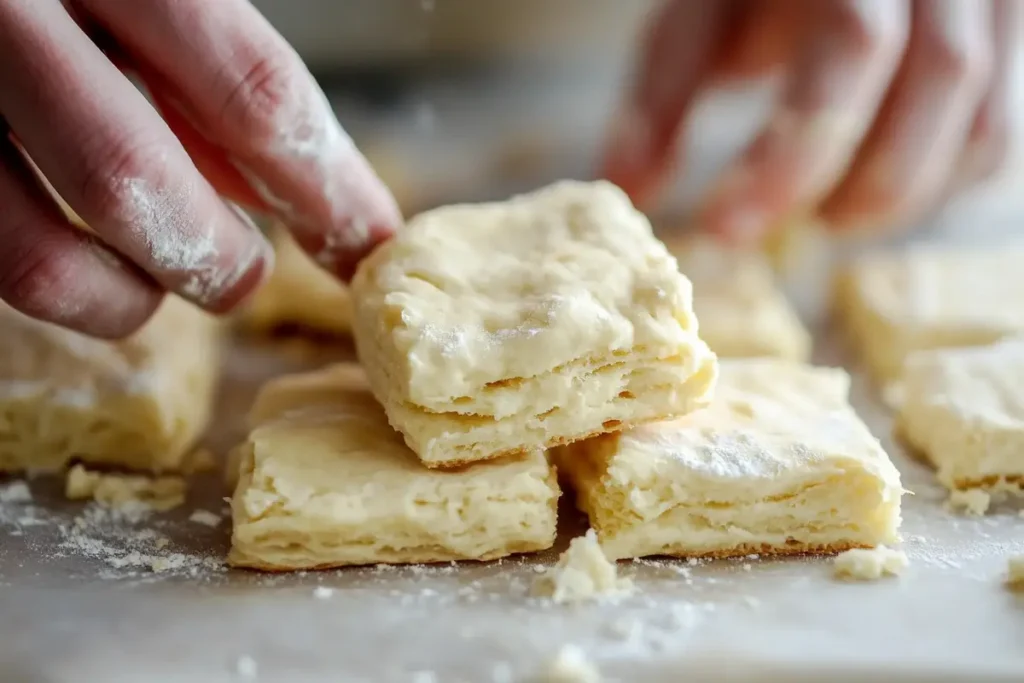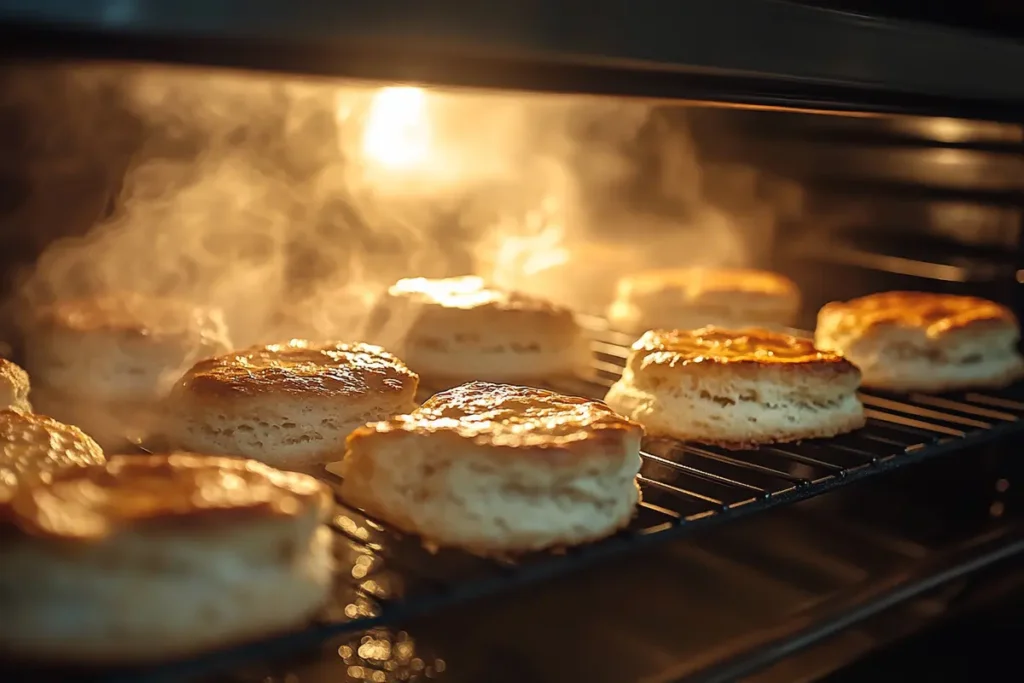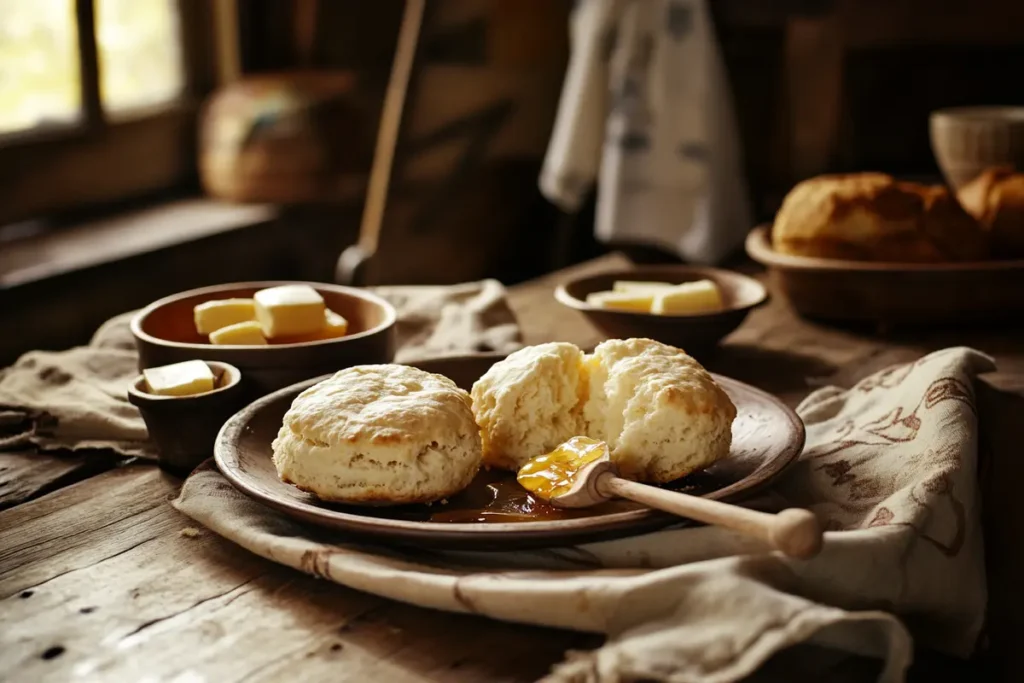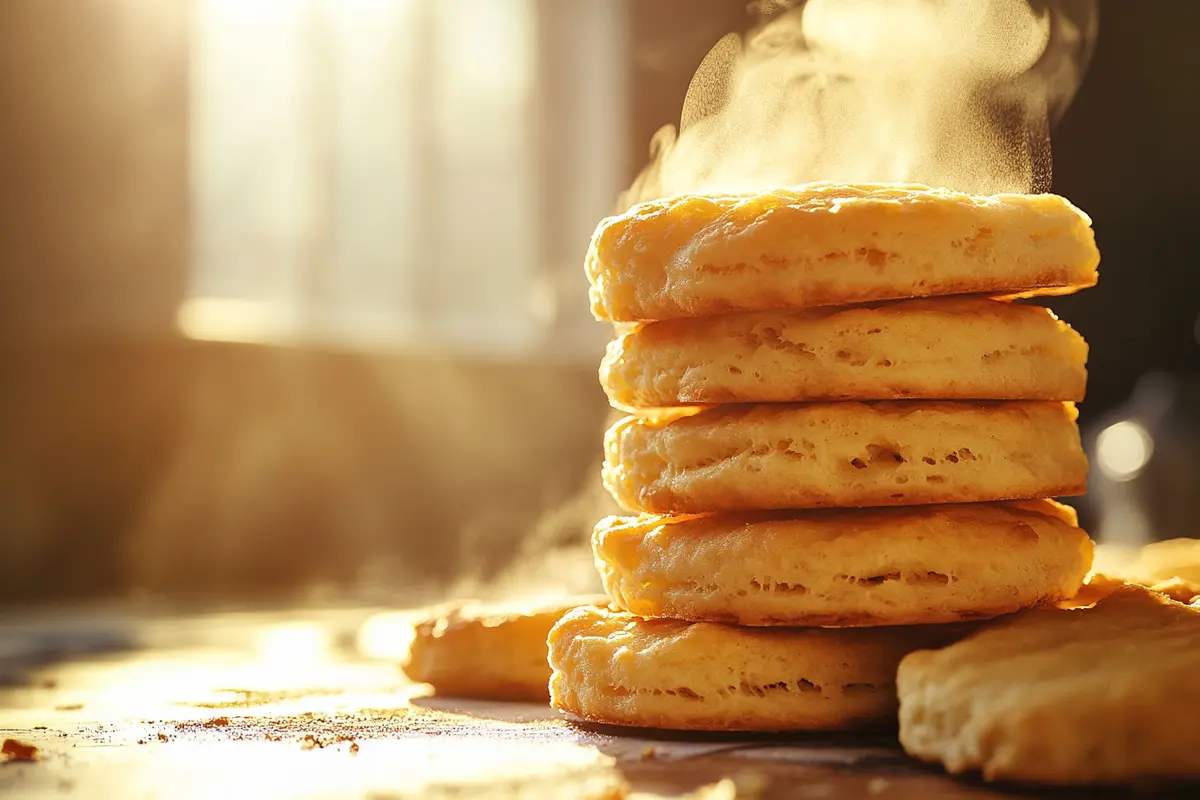When you walk into a kitchen filled with the warm scent of fresh biscuits, it sparks joy. For many, the question What is the secret to an excellent biscuit? lingers at the back of their minds. Biscuits seem simple—just flour, butter, and a bit of liquid. However, the path to that perfect, fluffy texture can feel elusive. In this article, we’ll break down every step and help you reach biscuit perfection with ease.
Understanding the Basics of a Perfect Biscuit
To discover what is the secret to an excellent biscuit? start with the fundamentals. Biscuits depend on a careful combination of ingredients and techniques. Every element, from flour selection to fat temperature, influences texture and flavor. Therefore, it’s crucial to understand these core components before you can achieve that heavenly flakiness.
- Flour: Choose a low-protein flour, such as Southern-style self-rising flour or a blend of pastry flour and all-purpose flour. This helps ensure that your biscuits remain tender and not overly chewy.
- Fat: Use cold butter or shortening to create layers of flaky goodness. The fat pieces should remain solid until the heat of the oven releases steam, causing the biscuits to rise.
- Leavening Agents: Baking powder and sometimes baking soda help biscuits rise. Use fresh, quality leaveners and measure precisely.
- Liquid: Buttermilk is a popular choice. It adds tangy flavor and helps with leavening when used in combination with baking soda.
- Technique: Mixing the dough gently, folding it, and shaping it correctly can make all the difference.
The Crucial Role of Proper Technique
When people ask what is the secret to an excellent biscuit? many overlook technique. However, technique can be as important as the ingredients. For example, overworking the dough can cause gluten formation, resulting in tough biscuits. By using a light hand, you’ll maintain a delicate structure.
In addition, pay attention to how you cut and shape the biscuits. Pressing the cutter straight down and lifting it straight up ensures clean edges. Twisting the cutter can seal the dough’s edges, reducing rise. Small details like these matter. They can mean the difference between a tall, fluffy biscuit and a flat, dense one.

Achieving the Ideal Texture: Flaky, Tender, and Moist
Excellent biscuits strike a balance between flaky layers, tender crumb, and moist interior. To achieve this, you need cold fat, minimal mixing, and proper folding. It may sound complex, but each step is simple.
- Keep Ingredients Cold: Butter and liquid should be cold. Chill your mixing bowl and utensils before you start.
- Mix Gently: Stop mixing as soon as the dough comes together. It should look slightly shaggy.
- Fold for Layers: Pat the dough into a rectangle, fold it in half, rotate, and repeat. This creates multiple layers without extensive kneading.
- Cut Cleanly: Use a sharp biscuit cutter and do not twist as you press down.
The Power of Temperature Control
Temperature impacts every step of biscuit-making. If your butter softens too much before baking, you lose those distinct layers and flakiness. Keep everything chilled until the moment the biscuits go into the oven. Once there, the initial burst of heat will cause the butter to release steam, helping the biscuits puff up.
If your oven runs hot or cold, calibrate it. An oven thermometer is an inexpensive tool that ensures accurate baking temperatures. Maintaining a consistent baking environment helps your biscuits rise to their full potential, revealing what is the secret to an excellent biscuit? in the process.
Choosing the Right Ingredients for Maximum Flavor
While technique is crucial, flavor depends on the quality of your ingredients. Experiment with different buttermilks, high-quality European-style butter, and even specialty flours. For savory twists, consider adding a pinch of cayenne, grated cheese, or fresh herbs. For a sweet variation, incorporate a touch of sugar and some dried fruit.
Flour
- All-Purpose Flour: Versatile, but can lead to slightly denser biscuits.
- Pastry Flour: Lower protein content yields more tender biscuits.
- Self-Rising Flour: Convenient for quick biscuit recipes. Contains leavening agents and salt already blended.
Fat
- Butter: Provides flavor and flaky layers. Use unsalted butter and add salt separately for control.
- Shortening: Yields a very tender crumb, but less flavor.
- Lard: Traditional, rich flavor and excellent flakiness. Make sure it’s fresh and high quality.
Liquid
- Buttermilk: Tangy, aids leavening, and tenderizes.
- Whole Milk: Less tangy, still yields tender biscuits.
- Cream: Rich, luxurious texture, but watch the fat content.
Balancing Leavening and Flavor
To understand what is the secret to an excellent biscuit? you must balance leavening agents and flavors. Baking powder and baking soda are not only leaveners but also influence taste. Too much can create a bitter aftertaste, while too little results in flat biscuits. Adjust your recipe to ensure a delicate rise without overpowering flavors.
For an added depth of flavor, consider replacing some of your buttermilk with yogurt or sour cream. These cultured dairy products can introduce subtle tang and complexity, all while enhancing tenderness.
Shaping and Cutting: The Art of Biscuit Formation
When shaping biscuits, work on a lightly floured surface and handle the dough gently. Pat it into a rectangle, fold it a few times, and then pat into a final shape about 1-inch thick. Use a sharp cutter, dip it in flour, and press straight down. Do not twist. Place the biscuits on a baking sheet so that they almost touch, encouraging them to rise upward rather than spread out. This subtle trick can be part of the answer to what is the secret to an excellent biscuit?
Oven Temperature and Baking Time
Preheat your oven well before baking. A hot oven ensures immediate steam release from the butter. Usually, 425°F to 450°F works best for biscuits. Start checking them at about 12 minutes for smaller biscuits, or around 14-15 minutes for larger ones. Look for a golden-brown top and a baked-through, fluffy interior.
If you’re new to biscuit baking, consider making a small test batch first. Tweak the baking time or temperature as needed. Such practice sessions increase your confidence and help you pinpoint what is the secret to an excellent biscuit? for your specific oven and environment.

Enhancing Flavor with Add-Ins and Variations
Biscuits can serve as a blank canvas. Once you master the basic version, experiment with additions.
- Cheddar and Chive: Add shredded sharp cheddar and minced chives for a savory spin.
- Herb and Garlic: Mix in dried rosemary, thyme, or garlic powder.
- Fruit and Sugar: Fold in dried cranberries or raisins and sprinkle with coarse sugar before baking.
These variations change not only flavor but texture. They can also help you better understand ingredient interplay and thus deepen your grasp of what is the secret to an excellent biscuit?
Mastering the Texture Through Folding
Folding the dough is like creating biscuit “laminations.” Each fold multiplies the number of layers. This technique, often associated with puff pastry, is a secret to creating lofty, flaky biscuits. Fold the dough two or three times, rotating 90 degrees after each fold. Each time you fold, you are building structure. The steam produced when the butter melts and the leaveners activate will force these layers apart.
Keeping it Simple: Minimal Handling Yields Better Results
When people think about what is the secret to an excellent biscuit? they might guess complex methods. However, sometimes less is more. Overmixing creates too much gluten, making biscuits tough. Over-flouring dries them out. Applying too much pressure when shaping can collapse the delicate layers.
Handle the dough as little as possible. Mix just until the dough holds together. Pat or roll gently, fold with care, and be thoughtful with every action. This mindful approach leads to consistently airy, tender biscuits.
Perfect Pairings: Serving Suggestions for perfect biscuit
Biscuits stand on their own, but pair them with spreads and meals to enhance enjoyment.
- Butter and Honey: Classic and simple.
- Jam or Preserves: Add sweetness and fruitiness.
- Gravy or Sauces: Biscuits and gravy are a breakfast favorite.
- Soups and Stews: Use biscuits as a comforting side.
These serving ideas do not just please the palate. They highlight the biscuit’s versatility and show why understanding what is the secret to an excellent biscuit? is worthwhile.

Using the Right Tools for the Job
Quality tools make biscuit baking easier and more consistent.
- Pastry Cutter or Food Processor: For cutting butter into flour efficiently.
- Bench Scraper: Ideal for folding and shaping.
- Sharp Biscuit Cutter: Ensures clean cuts and better rise.
- Baking Sheet or Cast-Iron Skillet: Conducts heat evenly, ensuring a well-browned exterior.
These tools may not directly reveal what is the secret to an excellent biscuit? but they remove obstacles that hinder perfect results.
Troubleshooting Your Biscuits
If your biscuits are not rising as expected or taste bland, consider these troubleshooting tips.
- Flat Biscuits: Check that your baking powder is fresh and your fat is cold.
- Dry Biscuits: Add a bit more liquid or reduce baking time slightly.
- Bland Flavor: Increase salt slightly or experiment with cultured dairy for tanginess.
Finding solutions to these issues helps you refine your technique and get closer to that elusive secret. Soon, your biscuits will consistently impress, and you’ll know the answer to what is the secret to an excellent biscuit?
Step-by-Step Recipe for perfect Biscuits
Below is a simple recipe that encapsulates many principles we’ve discussed. Adjust it to suit your taste, but start here to master the basics.
Ingredients:
- 2 cups pastry flour or self-rising flour
- 1 tablespoon baking powder (if using plain flour)
- ½ teaspoon baking soda (if using buttermilk)
- ½ teaspoon salt
- 5 tablespoons cold unsalted butter, cut into small cubes
- ¾ to 1 cup cold buttermilk
Instructions:
- Preheat oven to 425°F.
- Whisk flour, baking powder, baking soda, and salt in a large bowl.
- Cut in butter until pea-sized pieces remain.
- Add buttermilk gradually. Stir just until dough holds together.
- Turn dough onto a floured surface. Pat into a rectangle and fold in half. Rotate 90 degrees. Repeat twice.
- Pat dough to about 1-inch thickness. Use a sharp biscuit cutter to cut biscuits.
- Place biscuits close together on a baking sheet.
- Bake 12-15 minutes until golden and risen.
- Serve warm with butter or desired toppings.
This process shows you how technique, ingredient selection, and careful handling converge. With this recipe, you begin to answer what is the secret to an excellent biscuit? on your own terms.
Conclusion: Embrace Simplicity and Quality for an excellent biscuit
Ultimately, the answer to what is the secret to an excellent biscuit? lies in the harmony of technique, quality ingredients, and mindful preparation. Keep your butter cold, handle your dough gently, and respect your ingredients. Use proper leavening, measure carefully, and consider your oven’s quirks. Add your personal touch with herbs, cheese, or sweetness. Over time, you’ll develop a feel for biscuit dough, and perfect biscuits will become second nature.
Understanding these principles unlocks the door to consistently great biscuits. When you bite into a warm, tender, and flaky biscuit, you’ll know that you’ve discovered the secret. Now it’s time to share that knowledge—and those biscuits—with the world.
Frequently Asked Questions
What makes a high quality biscuit?
A high quality biscuit is tender, flaky, and rises tall. The butter stays cold until baking, ensuring distinct layers. Quality flour, fresh leaveners, and gentle handling also matter. Avoid overmixing to prevent tough dough. Proper shaping, cutting, and baking at the right temperature yield a biscuit with a moist interior and a lightly crisp exterior.
What does adding an egg to biscuits do?
Adding an egg to biscuit dough can enrich the flavor and color. It also provides a bit more structure. However, eggs can make the biscuit slightly denser. If you prefer lighter biscuits, skip the egg. Experiment until you find a balance that suits your taste.
What is the secret of biscuits?
The secret of biscuits lies in maintaining cold ingredients, using low-protein flour, and handling the dough minimally. Proper folding creates layers, and fresh leaveners ensure a good rise. Paying attention to every detail—from mixing to baking—yields fluffy, flavorful biscuits every time.

